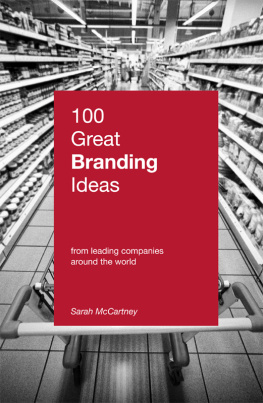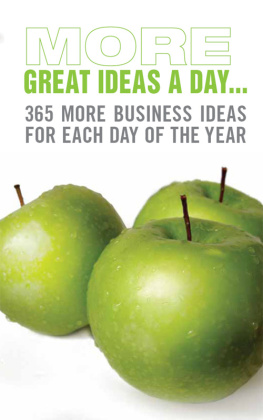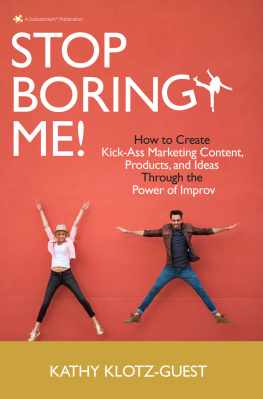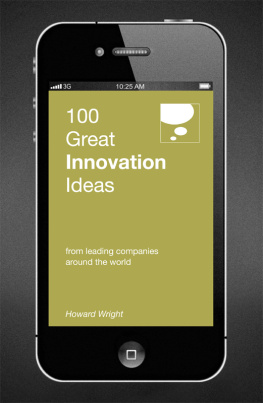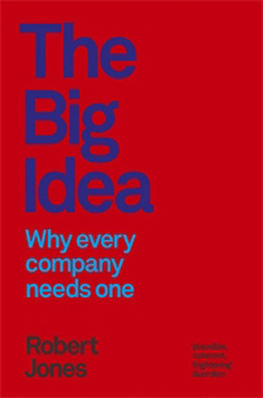GREAT BRANDING
IDEAS
Sarah McCartney
Copyright 2012 Sarah McCartney Cover art: Opal Works Co. Ltd.
First published in 2012 by Marshall Cavendish Business
An imprint of Marshall Cavendish International
PO Box 65829
London EC1P 1NY
and
1 New Industrial Road, Singapore 536196
www.marshallcavendish.com/genref
Other Marshall Cavendish offices: Marshall Cavendish International (Asia) Private Limited, 1 New Industrial Road, Singapore 536196 Marshall Cavendish Corporation. 99 White Plains Road, Tarrytown NY 10591-9001, USA Marshall Cavendish International (Thailand) Co Ltd. 253 Asoke, 12th Flr, Sukhumvit 21 Road, Klongtoey Nua, Wattana, Bangkok 10110, Thailand Marshall Cavendish (Malaysia) Sdn Bhd, Times Subang, Lot 46, Subang Hi-Tech Industrial Park, Batu Tiga, 40000 Shah Alam, Selangor Darul Ehsan, Malaysia
Marshall Cavendish is a trademark of Times Publishing Limited
The right of Sarah McCartney to be identified as the author of this work has been asserted by her in accordance with the Copyright, Designs and Patents Act 1988.
All rights reserved
No part of this publication may be reproduced, stored in a retrieval system or transmitted, in any form or by any means, electronic, mechanical, photocopying, recording or otherwise, without the prior permission of the copyright owner. Requests for permission should be addressed to the publisher.
The author and publisher have used their best efforts in preparing this book and disclaim liability arising directly and indirectly from the use and application of this book.
All reasonable efforts have been made to obtain necessary copyright permissions. Any omissions or errors are unintentional and will, if brought to the attention of the publisher, be corrected in future printings.
A CIP record for this book is available from the British Library
eISBN 978-981-4382-61-8
Printed and bound in Great Britain by
TJ International Limited, Padstow, Cornwall
CONTENTS
The ideas
For all the things Ive picked up about brands along the way, Id like to thank colleagues at DArcy McManus & Masius and the Guardian and Observer newspapers, and clients past and present.
Id like to say thankyou (which is one word, despite spellcheckers determination to break it into two) to the people who make me think hard, including Mary Linehan (PR goddess), Stephen Zades, Nick Randell, Ben Afia and the board of 26.
Particular thanks to Martin Liu at Marshall Cavendish who listens to my ideas, quite often commissions them, then lets me get on and write them.
INTRODUCTION
Whether you run a multinational or a social enterprise, a charity or a one-man-band, you have a brand.
Branding is all about deciding where you stand, and what makes you different from the others, then showing and telling the difference as clearly as you can to make you brand stand out.
Everything that a brand is and does forms part of its identity.
Building a brands identity makes it more recognisable, familiar and reassuringas long as you get it right. If its all going well, then people are more likely to chose your brand, use it and tell their friends about it.
Your branding is working when youve got people saying, Yes, I know them. Theyre the people who ...
... have the big blue building in the centre of town.
... make those delicious biscuits.
... sponsor our football team.
... designed my favourite jacket.
Whats important is that people remember the good things about your brand, come back to it or recommend it to people they know, and dont get you mixed up with someone else.
In this book, there are 100 branding ideas; some are about brand strategy and some about specific actions you could take. Use them to give you direction, or to help evaluate the branding youre already doing. You can read it from start to finish, or you can also pick a page at random.
All the stories are here to make a point, not just as anecdotes. I use them to shed light on a situation that might arise again, and which you might approach differently for your own brand.
They wont all be relevant to you right now but some of them will, and I do hope they give you something new to think about, debate and adapt for your own use.
Brands are peoples and organisations intellectual property, so youll have to adapt some of the examples Ive written about before you can apply a similar idea to your own organisation. But thats where innovation and creativity come in; define what you can and cant do, and this will help you to invent a your own solution to a particular problem.
PS
Point 101: Tell the truth. In these days of social media and the speed that news can travel around the Internet, if you try to put a glossy face on a grubby reality, youll get found out. The best branding comes from building a great organisation, then letting people know all about it.
 | KNOW WHAT A BRAND IS |
People think they know what brands are, but often they dont. Ive heard business people say, Oh no, we dont really have a brand, we just run a business. Clothes shoppers will tell me, I dont buy brands, theyre too expensive. I go to the Gap, Next or Uniqlo.
A brand isnt something thats too expensive for most of us to buythats a luxury brand. A brand is any product or service (and occasionally an individual) that stands out from the others around it because of its positioning or its personality. All organisations are brand owners whether they like it or not, and theyve a responsibility for how other people regard that brand.
The most important thing is to stand out.
The idea
A brand is much more than a logo or a name. As well as its easily defined features, like its colour and its location, its made up of the feelings it evokes in people. Each individual will feel something different about the brand according to personal experience, and this is something a brand owner cant control.
However you should still give it your best shot. As the brand owner, its your responsibility to influence the way people think about your brand, and you do that by taking care of each experience your customers have when they come into contact with the organisation. Dividing a brand into positioning and personality comes from an excellent academic book, Branding In Action, by Graham Hankinson and Philippa Cowking.
When they talk about positioning, they mean where your brands fit compared with all the others you compete with. Where do you fit in the price versus quality scale? And what do people use your brand for?
With personality, Hankinson & Cowkings book includes things that you definitely control, like the typeface you use your corporate colours your logo, where youre based, where people come into contact with you.
Personality is also made up of perceptions which are much more difficult to pin down. How do people see you? Are you traditional or modern? Are you safe or risky? Do people think youre really good value or cheap? Do people think your excellent quality or way too expensive, or both?

